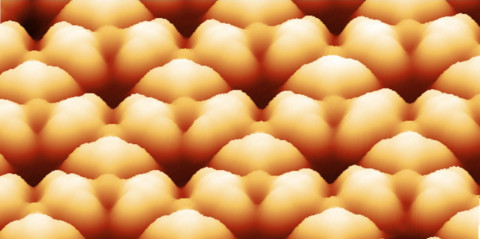Researchers create the world's thinnest hard magnet

An international team of researchers involving the Material Science Institute of Madrid (ICMM-CSIC) and led by the Aragon Institute of Nanoscience and Materials (INMA-CSIC-UNIZAR) has created an atomic-thick hard magnet for the first time worldwide. It is the thinnest magnet ever created and that can ever exist, with a defined magnetic direction, relatively high temperature, and very difficult to demagnetize. After seven years of study, this discovery represents a clear advancement in the cross-cutting fields of magnetism and surface science, as it has been a goal pursued by various teams of scientists worldwide for more than two decades. The results are published in the journal Nature Communications.
Fernando Bartolomé, a CSIC researcher at INMA and currently the Education Counselor in the United Kingdom and Ireland, and Jorge Lobo Checa, also a scientist at INMA and a reference researcher at the Advanced Microscopy Laboratory (LMA), are the architects of this achievement: reducing a hard magnet to its minimum expression, within the current general trend of miniaturization, which aims to obtain increasingly smaller elements that occupy the least possible space, without losing their properties.
"We have managed, through a combination of iron molecules and atoms, to generate a network where the atoms are separated from each other at a fixed distance and present a magnetization direction perpendicular to this network," explains Lobo. The combination of materials referred to is a molecule derived from anthracene (three carbon rings) and iron atoms. Thus, a network (like the structure of a honeycomb) is obtained where the iron atoms are positioned at the vertices of the hexagons.
The hardness of the magnet
As for the hardness of this hyperfine magnet, it is defined by the difficulty in reversing the magnetization direction. "The field that determines the hardness of a ferromagnetic material is the intensity of the magnetic field that must be applied to that material to invert its magnetization. This indicates how hard or soft it is. And the more it costs to change the direction of magnetization, the harder it is," highlights Lobo. In Bartolomé's words: "The hardness of this atomic-thick magnet is similar to that of neodymium magnets."
This advancement in basic science has potential practical applications in any technological device where it is necessary to incorporate a magnetic field, for example, a computer's RAM memory or a transistor. "It will be very useful for further miniaturizing things due to its small size. It is important to note that in this magnet, iron atoms are separated by distances of one nanometer, that is, one-millionth of a millimeter," illustrates Lobo.
The work has been developed by an international team led by INMA, with the collaboration of the Advanced Microscopy Laboratory (LMA) of UNIZAR - administratively linked to INMA -, the ALBA Synchrotron, and the SAI of UNIZAR. From INMA, Leyre Hernández López, David Serrate (also director of the SPM area of LMA), and the newly incorporated researcher Mikhail M. Otrokov have also contributed to the research. Likewise, Ignacio Piquero Zulaica (Technical University of Munich); Adriana Candia (Institute of Physics of the Littoral, Argentina); Pierluigi Gargiani and Manuel Valvidares, scientists from the ALBA synchrotron; Fernando Delgado (University of La Laguna); Jorge Cerdá (ICMM Madrid); and Andrés Arnau (University of the Basque Country) have worked on the project.
Referencia científica:
Jorge Lobo-Checa, Leyre Hernández-López, Mikhail M. Otrokov, Ignacio Piquero-Zulaica, Adriana E. Candia, Pierluigi Gargiani, David Serrate, Fernando Delgado, Manuel Valvidares, Jorge Cerdá, Andrés Arnau and Fernando Bartolomé. Ferromagnetism on an atom-thick & extended 2D metal-organic coordination network. Nature Communications. DOI: 10.1038/s41467-024-46115-z
Instituto de Ciencia de Materiales de Madrid (ICMM)
Sor Juana Ines de la Cruz, 3
Cantoblanco, 28049
Madrid, España
Telephone: (+34) 91 334 90 00
Email: @email
Communication Office: @email

Acknowledge the Severo Ochoa Centres of Excellence program through Grant CEX2024-001445-S/ financiado por MICIU/AEI / 10.13039/501100011033

Contacto | Accesibilidad | Aviso legal | Política de Cookies | Protección de datos